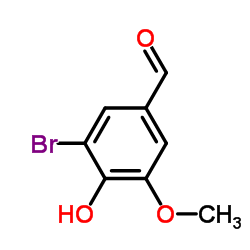5-Bromovanillin

5-Bromovanillin structure
|
Common Name | 5-Bromovanillin | ||
|---|---|---|---|---|
| CAS Number | 2973-76-4 | Molecular Weight | 231.043 | |
| Density | 1.7±0.1 g/cm3 | Boiling Point | 289.5±35.0 °C at 760 mmHg | |
| Molecular Formula | C8H7BrO3 | Melting Point | 164-166 °C(lit.) | |
| MSDS | Chinese USA | Flash Point | 128.9±25.9 °C | |
| Symbol |

GHS07 |
Signal Word | Warning | |
|
Dechlorination of chlorocatechols by stable enrichment cultures of anaerobic bacteria.
Appl. Environ. Microbiol. 57(1) , 77-84, (1991) Metabolically stable anaerobic cultures obtained by enrichment with 5-bromovanillin, 5-chlorovanillin, catechin, and phloroglucinol were used to study dechlorination of chlorocatechols. A high degree of specificity in dechlorination was observed, and some chl... |
|
|
Enzymatic release of halogens or methanol from some substituted protocatechuic acids.
J. Bacteriol. 162(2) , 693-7, (1985) Four strains of gram-negative bacteria capable of growing at the expense of 5-chlorovanillate were isolated from soil, and the metabolism of one strain was studied in particular detail. In the presence of alpha, alpha'-bipyridyl, a suspension of 5-chlorovanil... |
|
|
Hydroxylation reaction catalyzed by the Burkholderia cepacia AC1100 bacterial strain. Involvement of the chlorophenol-4-monooxygenase.
Eur. J. Biochem. 261(2) , 533-9, (1999) The Burkholderia cepacia AC1100 strain, known to degrade the herbicide, 2,4,5-Trichlorophenoxyacetic acid (2,4,5-T), is able to metabolize 4-hydroxyarylaldehyde, not only into the corresponding acid, but also into a new hydroquinone, 2,5-dihydroxyarylaldehyde... |